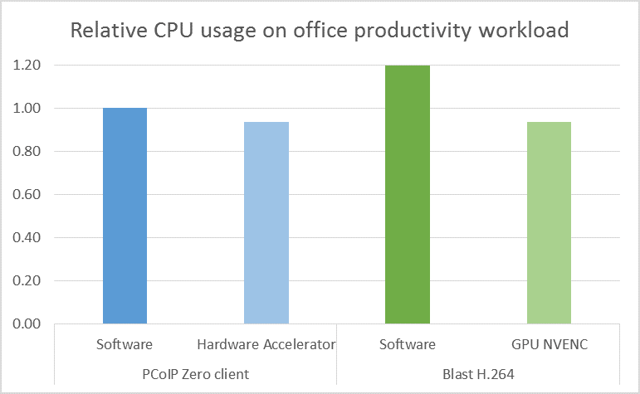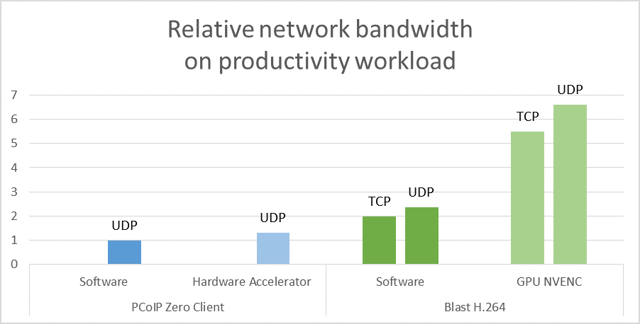HP Teradici
HP Teradici is the inventor of the PCoIP remote display protocol and develops the Engineering Emmy-Award-winning HP Anyware (formerly Teradici CAS) to deliver the best virtual and remote desktop experience in the world.
Graphics Processor Units (GPUs) are essential for delivering the rich, graphical experience for high-end, 3D applications such as CAD, GIS, Media and Entertainment, Oil and Gas Exploration, etc… However, the majority of users in a VDI or DaaS deployment are using 2D or lightweight 3D applications (e.g. Microsoft Office Suite) can easily be rendered using the CPU resources in the server making the benefits of using GPUs less obvious for these users. Thus, a properly designed display protocol needs to be able to deliver a great user experience whether a GPU is present or not while minimizing the impact on network bandwidth and the number of desktops that can be hosted on each server.
VMware's Blast Extreme is based on the video codec H.264 that can leverage the H.264 encoder hardware (NVENC) in NVIDIA M10 and M60 GPUs with GRID software licenses. However, when an M10 or M60 is not present, the server CPU must perform the H.264 encoding. Since H.264 was not designed as a computer display protocol, it requires significantly more CPU processing and consumes significantly more bandwidth than the PCoIP protocol which leverages multiple codecs optimized for delivering computer text and graphics. Not only does Blast impact the scalability of your servers and networks, but also the user experience is reduced.
PCoIP provides better server and network scalability with more cost-effective protocol acceleration
Let’s look at the server CPU utilization. The graph below shows the relative CPU loads when running an office productivity workload consisting of Adobe Reader, Microsoft Excel, Internet Explorer, PowerPoint, and Word. The two software bars have no GPU present and are using the latest VMware Horizon 7.0.2 with either the PCoIP or the Blast H.264 protocol. Without a GPU present, Blast is consuming ~20% more CPU which can reduce the number of desktops per server by ~20% compared to using PCoIP.

The second set of bars shows the relative CPU load when the PCoIP Hardware Accelerator card is added (without a GPU) to offload PCoIP and an NVIDIA M10-1Q GPU is introduced to offload Blast to the NVENC encoder. Both of these options provide similar reductions in CPU loading. The CPU reduction for both options would be even more pronounced if the workload included video or animation content.
...the costs per user are more than 6 times higher for the Blast option
While the offload benefits of the two options are similar, the costs per user are more than 6 times higher for the Blast option as shown in the table below. This doesn’t include the cost of the extra power and cooling requirements for the M10 GPUs or the fact that NVENC offload is currently limited to single-monitor clients (an example where Blast is not at feature parity to PCoIP).

PCoIP requires significantly less bandwidth on the network
The following graph highlights the impact the Blast H.264 protocol has on network bandwidth for the same productivity workload. Blast H.264 uses twice the network bandwidth as PCoIP when both are being encoded in software. While the PCoIP bandwidth increases slightly with the PCoIP Hardware Accelerator, the introduction of M10 NVENC H.264 offload with Blast increases the network bandwidth by more than 5X! Also note that Blast uses more bandwidth when you need to use UDP mode. Of course, PCoIP always uses UDP for the best experience on any network.

Beware the Hidden Costs & Lock-In
So, for typical VDI and DaaS users that do not really need the 3D performance provided by GPUs, selecting the Blast protocol will significantly impact the number of desktops per server that can be supported while generating at least twice the traffic on your networks. While the addition of an NVIDIA M10 GPU can reduce the CPU load and interactive latency, the bandwidth requirements are increased >5X, the image quality is still lossy, and the costs per user are >6X more than using a PCoIP Hardware Accelerator card. This makes PCoIP the obvious choice.
(for typical users) the Blast protocol will significantly impact the number of desktops per server that can be supported while generating at least twice the traffic on your networks.
Not only are you facing years of hidden costs associated with the choice of the Blast protocol, your choice is a limiting one: limiting on end-user monitor support and limiting future development. When you move to the cloud, your goal is to increase efficiencies, agility and scalability you don’t necessarily want to lock yourself into an ecosystem available from a single vendor. Customers around the world are enjoying the performance, security and multi-vendor benefits of the PCoIP protocol and PCoIP Zero Clients for VDI with VMware Horizon, for desktop-as-a-service with Amazon WorkSpaces and for workstation use cases with PCoIP Remote Workstation solutions.
Learn more about the differences between PCoIP and Blast Extreme...
HP Teradici
HP Teradici is the inventor of the PCoIP remote display protocol and develops the Engineering Emmy-Award-winning HP Anyware (formerly Teradici CAS) to deliver the best virtual and remote desktop experience in the world.
Posts by Tag
- Cloud Access Software (74)
- PCoIP (69)
- Cloud Computing (43)
- Media & Entertainment (40)
- Cloud Access (38)
- HP Anyware (38)
- PCoIP Technology (35)
- Zero Client (30)
- Teradici CAS (29)
- hybrid work (29)
- AWS (27)
- VDI (23)
- PCoIP Zero Clients (22)
- Amazon Workspaces (21)
- NVIDIA (21)
- CAS (20)
- Microsoft (20)
- PCoIP Ultra (20)
- Azure (19)
- Cloud Access Plus (19)
- Microsoft Azure (19)
- Google Cloud (18)
- GPU (17)
- VMware (17)
- Virtualization (15)
- Cloud Desktops (14)
- Remote Workstation (14)
- VFX (14)
- remote work (14)
- Amazon Web Services (13)
- VMware Horizon (13)
- cloud graphics (13)
- digital workspaces (13)
- Data Security (12)
- Google (12)
- Cloud Workflows (11)
- Amazon (10)
- Cloud Migration (10)
- End-point Security (10)
- GPUs in the Cloud (10)
- Remote Working (10)
- Virtual Desktops (10)
- DaaS (9)
- protocol (9)
- Autodesk (8)
- Cloud (8)
- Dell (8)
- Ian Main (8)
- Pervasive Computing Platform (8)
- SIGGRAPH (8)
- Security (8)
- virtual workstations (8)
- Cloud Workspaces (7)
- Game Development (7)
- Gaming (7)
- Hybrid Cloud (7)
- Interview (7)
- PCoIP Workstation Access Software (7)
- Remote Display Protocols (7)
- Video Editing (7)
- architecture (7)
- macos (7)
- multicloud (7)
- remote visualization (7)
- 3D graphics (6)
- Architecture Engineering Construction (6)
- Blast Extreme (6)
- Blast Extreme Vs PCoIP (6)
- CAD (6)
- COVID-19 (6)
- Cloud Access Platform (6)
- Collaboration (6)
- Desktop Access (6)
- Events (6)
- H.264 (6)
- HP (6)
- Hardware Accelerator (6)
- Horizon Protocols (6)
- NVIDIA Grid (6)
- Wacom (6)
- remote workforce (6)
- AMD (5)
- AWS re:Invent (5)
- Adobe (5)
- All Access (5)
- CAM (5)
- Cloud Security (5)
- Getting to know... (5)
- IGEL (5)
- Inside Teradici (5)
- NABShow (5)
- PCoIP Management Console (5)
- Q & A (5)
- Remote worksation (5)
- Thin Clients (5)
- Webinar (5)
- coronavirus (5)
- quarantine (5)
- remote graphics (5)
- Cloud Endpoints (4)
- Cybersecurity (4)
- GPU-Accelerated Cloud (4)
- Google Cloud Platform (4)
- HPE (4)
- Linux (4)
- Microsoft Ignite (4)
- N-Series GPU (4)
- NVIDIA GPU (4)
- Randy Groves (4)
- Remote Workspace (4)
- User Experience (4)
- auto offload (4)
- lossless (4)
- mac (4)
- AWS Marketplace (3)
- Amazon Workspace Graphics Bundle (3)
- Anyware Manager (3)
- Architecture, Engineering, and Construction (3)
- AutoCAD (3)
- Avid (3)
- CAD in the Cloud (3)
- Codecs (3)
- Dan Cordingley (3)
- Disaster Recovery (3)
- GCP (3)
- GTC (3)
- Google Cloud Next (3)
- Google Next (3)
- IBC (3)
- Jellyfish Pictures (3)
- LG (3)
- LucasFilm (3)
- Management Console (3)
- Maya (3)
- Microsoft Azure Marketplace (3)
- NAB (3)
- NVIDIA NVENC (3)
- Qumulo (3)
- Remote Desktop (3)
- Sohonet (3)
- Video (3)
- Virtual Machines (3)
- Workstations in the Cloud (3)
- Zero Client Deployment (3)
- broadcasting (3)
- business continuity (3)
- cas manager (3)
- linux desktops (3)
- movie production (3)
- pcoip encoding (3)
- remote workstation card (3)
- vmworld (3)
- zero trust architecture (3)
- 3D Workflow (2)
- AWS Graphics Bundles (2)
- AWS re:Invent 2018 (2)
- Adobe Premiere (2)
- Alex Herrera (2)
- Alta PCoIP Zero Clients (2)
- Amulet Hotkey (2)
- Apple (2)
- Arjen van der Meulen (2)
- Cloud Access Manager (2)
- Customer Story (2)
- DNEG (2)
- David Smith (2)
- EC2 Elastic GPU (2)
- FIPS (2)
- Federal Government (2)
- HP ZCentral Remote Boost (2)
- HTML5 (2)
- Healthcare (2)
- IBC 2018 (2)
- IBC 2019 (2)
- IBM (2)
- ILM (2)
- Industrial Light & Magic (2)
- Microsoft Build (2)
- Moore's Law (2)
- NVIDIA M60 (2)
- NVIDIA RTX6000 GPU (2)
- Oil & Gas (2)
- Scanline (2)
- Trusted Zero Client (2)
- VMworld 2016 (2)
- Workstation (2)
- Workstation Access (2)
- Z by HP (2)
- aws re:Invent 2019 (2)
- cloud solutions (2)
- data scientists (2)
- emmy (2)
- finance (2)
- hammerspace (2)
- lenovo (2)
- macstadium (2)
- omniverse (2)
- partner solutions (2)
- private cloud (2)
- server offload (2)
- tehama (2)
- virtual studio (2)
- wacom tablet (2)
- 10ZiG (1)
- 4K (1)
- 4K UHD Display (1)
- AEC (1)
- AI (1)
- AWS Endpoints (1)
- AWS Outposts (1)
- Adobe After Effects (1)
- Adobe Creative Suite (1)
- Adrian Graham (1)
- Android (1)
- Animation World (1)
- AnythingIT (1)
- Anyware Connector (1)
- Appsbroker (1)
- ArcGIS Pro (1)
- Atomic Cartoons (1)
- Autodesk 3DS Max (1)
- BCCDC (1)
- BVE (1)
- Bandwidth (1)
- Battery Life (1)
- BeBop Technology (1)
- Beaufort Memorial Hospital (1)
- Big Data (1)
- Brown Bag Films (1)
- CEEF16 (1)
- CP Technologies (1)
- CPU Load (1)
- CRN (1)
- Cadalyst (1)
- Careers (1)
- Celebrating 3 Million PCoIP Zero Clients (1)
- Certificate Management (1)
- Chris Feeney (1)
- Christus Health (1)
- Chrome (1)
- Chromebook (1)
- Cisco (1)
- Clearcube (1)
- Cloud Expo Europe (1)
- Cloud Expo Europe 2016 (1)
- Cloud Foundry Foundation (1)
- Compute (1)
- Connection Health Monitor (1)
- Crafty Apes (1)
- D-Wave (1)
- DISRUPT (1)
- DISRUPT EUC (1)
- DISRUPT Unite (1)
- DISRUPT2019 (1)
- DSB Consulting (1)
- Data Center 100 (1)
- Dell EMC (1)
- Disaster Recovery Plan (1)
- Disney (1)
- Don Listwin (1)
- EUC (1)
- Education (1)
- Elastic GPU (1)
- Emanuel Pirker (1)
- End User Computing (1)
- Esri (1)
- Event (1)
- Facebook (1)
- Fairfield Energy (1)
- Forbes (1)
- Forrest Smith (1)
- G3 Instances (1)
- GIS (1)
- General Availability (1)
- Google Cloud Marketplace (1)
- Google Marketplace (1)
- Government (1)
- Guest Post (1)
- HP RGS (1)
- HP t310 Quad-Display Zero Client (1)
- HP t310 Zero Client (1)
- HPA (1)
- HPE LoadRunner (1)
- HPE ProLiant (1)
- Hewlett Packard Enterprise (1)
- Higher Education (1)
- Hollywood Professional Association (1)
- Hyperclouds (1)
- IT Business Edge (1)
- Imprivata (1)
- Imprivata OneSign (1)
- Intel (1)
- Intel oneAPI Rendering Toolkit (1)
- Jeff Groudan (1)
- Jensen Huang (1)
- Jeremy Smith (1)
- Jon Peddie Research (1)
- Karan Batta (1)
- LDAP (1)
- MESA (1)
- Martin Traute (1)
- Mason City Clinics (1)
- Meltdown (1)
- Metro Health (1)
- Microsoft AVD Deployment (1)
- Mirela Cunjalo (1)
- NAB2017 (1)
- NAB2018 (1)
- NAB2019 (1)
- Neverware (1)
- Nexenta Systems (1)
- Nuke (1)
- OEM (1)
- OpenSDS (1)
- PCoIP Client (1)
- Quad Display (1)
- Quantum Computing (1)
- Rachel Berry (1)
- Rajen Sheth (1)
- Recycle (1)
- Release (1)
- Remote Display Protocol (1)
- SSO (1)
- Sagar Rawal (1)
- Sam Ramji (1)
- Schlumberger (1)
- Single Sign-On (1)
- Softlayer (1)
- Sony Pictures (1)
- Spectre (1)
- Star Wars (1)
- Steve Mueller (1)
- Stratodesk (1)
- Tablet (1)
- Tarkan Maner (1)
- Tech Talk Thursdays (1)
- TechTalk Thursdays (1)
- Tera2 (1)
- Terraform (1)
- The Angry Birds Movie (1)
- The Channel Co. (1)
- The Register (1)
- Thick Clients (1)
- Unigine Heaven (1)
- University of Waterloo (1)
- VDI Server Benchmarks (1)
- VDI Servers (1)
- VMBlog (1)
- VMware Horizon Clients (1)
- Virtual Reality (1)
- Virtualization 50 (1)
- Visualization (1)
- Webinar Series (1)
- Whitepaper (1)
- Work-from-Home Rapid Response Guide (1)
- Wyse (1)
- YOUNGTECH (1)
- Ziad Lamman (1)
- avid media composer (1)
- blade workstation (1)
- brianmadden.com (1)
- cleverDome (1)
- cloud deployments (1)
- community (1)
- connection broker (1)
- covid19 (1)
- dashboard (1)
- fabulatech (1)
- gpu acceleration (1)
- graphics acceleration (1)
- hypervisor (1)
- latency (1)
- leostream (1)
- local termination (1)
- nutanix (1)
- presentation (1)
- project workflows (1)
- promotion (1)
- protocol comparison (1)
- reference architecture (1)
- schools (1)
- studio Q (1)
- survey (1)
- technology partner program (1)
- test & monitoring tool (1)
- training (1)
- usb peripheral support (1)
- validation video (1)
- virtual display devices (1)
- virtual machine (1)
- vmware solution exchange (1)
- vsphere (1)
- webcam support (1)
- windows (1)
- windows virtual desktop (1)
- work from home (1)
- wvd (1)
- zero trust (1)